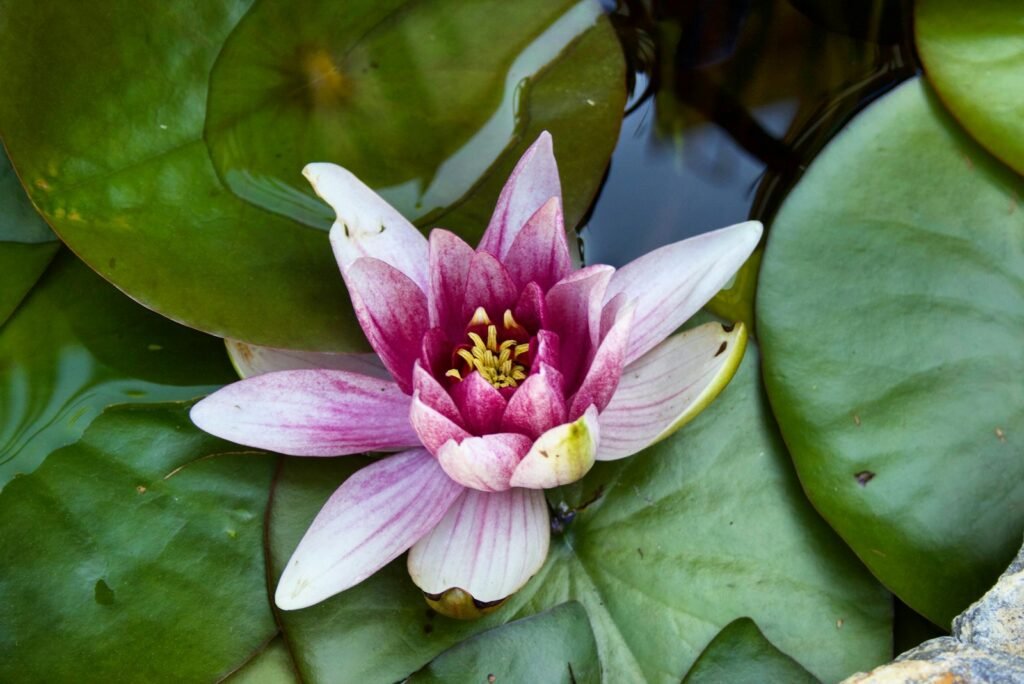In the Bible, flowers are more than just plants. They carry deep meanings and lessons. The lily is one such flower with a rich symbolism. It appears many times in the scriptures, offering spiritual messages to us.
So, what does a lily symbolize in the Bible? Why is it important? Let’s dive into the biblical meanings and spiritual significance of lilies to learn what they teach us.
The Symbolism of Flowers in the Bible
Flowers are deeply meaningful in the Bible, filled with symbolism and spiritual lessons. They remind us of deeper truths and divine messages. From life’s fleeting nature to themes of purity and new life, flowers are important in the Bible.
Many flowers in the Bible have specific meanings. For example, the almond symbolizes diligence and care. The lily reminds us of God’s beauty and provision.
Flowers like anise or dill also have deep meanings. They teach us to focus on what’s truly important in our spiritual lives.
Flowers teach us spiritual lessons, too. They show us about godliness, the shortness of life, and the importance of purity. Passages like Job 14:2 and Psalm 103:15-16 highlight how flowers symbolize life’s fleeting nature.
Some flowers are linked to important biblical figures and themes. The Madonna Lily stands for purity and divine love. The Easter Lily symbolizes resurrection and life after death.
During times of persecution, flowers were secret signs for early Christians. Lilies helped believers recognize each other and stay united in faith.
Flowers have also inspired Christian art and literature. They appear in famous paintings, linking believers to their faith.
Flowers are also part of the Christian liturgical calendar, especially during Eastertide. They symbolize resurrection and new life, adding spiritual depth to this season.
In conclusion, flowers in the Bible are more than just pretty. They carry deep meanings and spiritual lessons. They remind us of God’s presence and offer a way to connect with our faith.

The Significance of Lilies in Biblical Times
In biblical times, lilies were very important both culturally and spiritually. They were often mentioned in the Bible, showing their big role in Christian symbolism. These flowers were seen as symbols of purity and innocence. They were linked to figures like the Virgin Mary, Saint Anthony of Padua, and Saint Catherine of Siena.
Lilies were mentioned 15 times in the Bible, with 8 of those in the Song of Solomon. This book used lilies to talk about love and beauty. The lily’s meaning went beyond its looks, standing for purity, life, goodness, innocence, and hope.
The Easter Lily, native to southern Japan, became important during the Second World War. It needs special care and the right climate and soil to grow well. This flower is a symbol of resurrection and purity.
In the U.S., the area where California and Oregon meet is now called the Easter Lily capital. This is because Easter Lilies are grown there. These lilies are seen as the traditional Easter flowers, showing their big role in Christianity.
Lilies also have a deep meaning connected to motherhood in old stories and myths. The white lily is linked to the Virgin Mary in Roman Catholic tradition. It’s often shown in art to represent Mary’s Resurrection.
The Bible also links lilies to Jesus Christ, showing qualities like sweetness, purity, fruitfulness, humility, and healing.
The lily’s deep cultural and spiritual meaning makes it a lasting symbol of beauty, purity, and devotion to the spirit.
The Symbolism of Lilies in the New Testament
In the New Testament, Jesus taught about lilies with deep meaning. He used them as a metaphor in Matthew and Luke. This showed a powerful message to his followers.
Matthew 6: 28-29 says, “Consider the lilies of the field, how they grow: they neither toil nor spin, yet I tell you, even Solomon in all his glory was not arrayed like one of these.” Lilies symbolize God’s care for His creation. Jesus tells us not to worry about what we need. Instead, trust in God’s care, just like the lilies grow without trying.
Luke 12:27 also talks about lilies, saying, “Consider the lilies, how they grow: they neither toil nor spin, yet I tell you, even Solomon in all his glory was not arrayed like one of these.” This verse also talks about God’s care for us and how we shouldn’t worry.
The type of lily mentioned isn’t clear, but scholars think it might be the scarlet martagon or “red Turk’s-cap lily.” This lily grows a lot in Galilee, where Jesus taught. It fits well with his message.
Jesus compares Solomon’s wealth to the simple beauty of lilies. This shows the difference between chasing after the world and trusting in God’s care. The lilies remind us to trust in God’s care, not worry about what we need.
Lilies in the New Testament symbolize God’s care, support, and the difference between our worries and God’s love. They are often used as a metaphor in Jesus’ teachings. This reminds believers to trust in God’s faithfulness and plenty.
Lilies vs. Other Flowers in the Bible
Lilies are very important in the Bible, but they’re not the only flowers mentioned. Many other flowers have their own meanings and messages. Let’s look at how lilies compare with other flowers and their symbolism in the Bible.
In the New Testament, Jesus is seen as unique, like a lily. The lily’s shape, size, smell, and wide acceptance show how special Jesus is.
Lilies are also found in the Old Testament, in the Song of Solomon. There, they symbolize beauty in hard times. This shows how lilies can grow strong, teaching us to stay strong in our faith.
Lilies mean purity and innocence, but other flowers have their own symbols. For example, the rose of Sharon stands for a woman’s beauty and uniqueness. A man sees his loved one as a lily among thorns. This shows the balance in relationships, valuing each other’s strengths and beauty.
Some think the wild anemone, hyacinth, tulip, iris, and gladiolus could be the “lily of the valley” in the Bible. But the anemone is likely the best match because it’s common and beautiful in Israel during spring.
Lilies are important in the Bible’s flower symbolism, but so are other flowers. Each flower has its own message, adding to the spiritual truths in the Bible.
Understanding the symbolism of flowers in the Bible helps us value their wisdom and beauty. Flowers like lilies and others have inspired art and helped in medicine for centuries.
Let’s take lessons from the flowers in the Bible. We can aim to be pure, kind, and spread the message of Jesus. Just as lilies are abundant and spread out, let’s share the gospel through our actions, staying true to our faith.
The Symbolic Meanings of Other Flowers in the Bible
The Bible is full of flowers with deep meanings. These flowers were picked for their messages and spiritual significance. Let’s look at some flowers that hold special meanings in the Bible.
The Rose: Symbolizing Love, Beauty, and Hope
The rose isn’t often mentioned in the Bible but it’s very symbolic. It stands for love, beauty, and hope. Its beauty and scent make it a symbol of love and affection. The rose reminds us of God’s love and the hope He offers through grace.
The Myrtle: Symbolizing Peace, Prosperity, and Blessings
The myrtle is a flower with deep meaning in the Bible. It means peace, prosperity, and God’s blessings. Its green leaves and white flowers show the peace and abundance from following God’s ways. It reminds us of God’s faithfulness and the blessings He gives us.
The Olive: Symbolizing Peace, Prosperity, and Endurance
The olive tree is very important in the Bible. It stands for peace, prosperity, and enduring. Its ability to survive tough times and produce fruit shows its strength and God’s care. It reminds us of God’s peace in hard times and His provision.
The Mustard Seed: Symbolizing Faith and the Growth of God’s Kingdom
The mustard seed is a small but powerful symbol in the Bible. It represents faith and the growth of God’s kingdom. Despite being small, it can grow big. This shows the power of faith and the blessings from a relationship with God.
These flowers and plants in the Bible have deep symbolism and lessons for us. By understanding their meanings, we can find inspiration and guidance in our lives.
The Power of Flower Symbolism in the Bible
Flower symbolism in the Bible is powerful and significant. It shapes how readers connect with the text and its teachings. Flowers as metaphors in the Bible highlight themes like beauty, growth, and God’s blessings.
Flowers like lilies, roses, and olive branches are key symbols in the Bible. Each flower has its own meaning. For example, roses stand for love, lilies for purity, and olive branches for peace. These symbols help readers understand spiritual lessons in the Bible.
In Matthew 6:28-29, Jesus talks about lilies to show God’s care for creation. He points out the beauty and growth of lilies to teach trust in God’s providence. This shows how flowers symbolize faith in God’s care.
Flowers in the Bible are more than just pretty. They shed light on God’s messages about creation, His relationship with us, and eternal truths. Through flowers, readers can see the spiritual journey of biblical characters and think about deeper themes.
Flower symbolism also connects readers with the Bible. When we see flowers in the Bible, it makes us pause and think about the spiritual message. Flowers draw us in and help us understand God’s love, grace, and faithfulness better.
Lilies are very popular, being the fourth most popular flower globally. They’ve been around for over 3,000 years and are important in many cultures. The Song of Songs talks about lilies a lot, showing their special meaning in religious contexts.
Flowers also have historical and cultural ties that add to their significance. The Madonna Lily, a type of Easter Lily, is one of the oldest cultivated lilies. It shows the flower’s long history and cultural importance. St. Anthony is linked with lilies, showing a deep connection between the saint and the flower.
The tradition of blessing lilies in memory of St. Anthony’s purity dates back to the French Revolution. This shows how flower symbolism has lasted through history, even in tough times.
Flower symbolism in the Bible touches readers from all walks of life. Flowers remind us of God’s love, purity, peace, and more. They make the Bible’s stories come alive, deepening our spiritual journey.
The Timeless Wisdom of Biblical Flowers
Flowers in the Bible carry deep wisdom and lessons that still matter today. They teach us important things about life. Let’s look at some key flower symbols in the Bible and what we can learn from them.
The Lily: Symbol of Purity and Beauty
The lily is a major symbol in the Bible. It stands for purity and beauty, as seen in the Song of Solomon 2:1. Its beauty reminds us to keep our lives pure and beautiful.
The Rose: Representation of Christ’s Beauty and Love
The rose is also important, even though it’s not directly mentioned in the Bible. It’s linked to Christ’s beauty and love. Isaiah 35:1-2 says the desert blooms like a rose, showing Christ’s power to change lives. The rose teaches us about Jesus’ love and how to share it with others.
Other Flower Symbols and Their Lessons
Other flowers in the Bible have their own symbols and lessons. The myrtle shows us how we can change for the better, as Isaiah 55:13 says. The olive tree stands for peace and plenty, teaching us to live in harmony with others, as Psalm 52:8 says.
The mustard seed shows us how big things start small, like the Kingdom of Heaven, as Matthew 13:31 explains. It tells us to believe in our actions and their potential. Hyssop means purification, calling us to clean our hearts, as Psalm 51:7 says.
The almond reminds us to watch over God’s words, just like Jeremiah 1:11 says. The fig tree is a sign of God’s presence in our lives, as Matthew 24:32-33 tells us. The pomegranate stands for fertility and spiritual growth, encouraging us to grow and appreciate God’s creations.
The willow symbolizes strength in hard times, as Psalm 137:1-2 explains. It teaches us to stay strong and overcome challenges.
Even though some flowers aren’t named in some Bibles, their meanings and connections with similar flowers help us understand their deep messages.
Relevance of Flower Symbolism Today
Flower symbolism is still very important today. It helps us understand the Bible’s wisdom and teachings. These lessons help us build better relationships, grow virtues, and find comfort in tough times. Flowers also inspire us to see God’s love and care in creation.
The lessons from biblical flowers are timeless and still guide us today. Let’s use their wisdom to make our lives richer and deepen our spiritual path.
Flowers in Other Holy Books
Flower symbolism is big in the Bible, but it’s not just for Christians. Other holy books also talk about flowers and what they mean. This shows how nature and spirituality connect across different beliefs.
Flower Symbolism in Other Holy Books
In the Quran, flowers are important too. They mean a lot to believers, just like in the Bible. This shows how human experiences and the divine are linked.
Flowers make us feel deep emotions and make us think about big spiritual questions. In many religions, they carry messages from the divine. They teach us important lessons.
Learning about flower symbolism in different holy books helps us see deeper spiritual connections. It shows how wisdom and teachings are shared across faiths. This connects people of different beliefs.
Flowers help bridge gaps between religions. They bring people together, promoting understanding and respect. They remind us of the deep messages nature shares with us all.
Appreciating the Symbolic Beauty of Flowers in the Bible
Flowers in the Bible are more than just pretty decorations. They carry deep spiritual meanings. By understanding these meanings, we can connect more with the Bible and find spiritual inspiration.
Scripture often uses flowers as symbols of life’s fleeting nature. Like flowers that bloom and then fade, our lives are short. The Bible uses flowers to remind us to live in the moment and seek deeper meaning.
In Isaiah 40:6-8 and James 1:10-11, flowers symbolize life’s shortness and the impermanence of beauty. These symbols urge us to focus on the eternal and spiritual, not just the here and now.
Flowers also represent spiritual growth, God’s care, and change. In Matthew 6:28-30 and Song of Solomon 2:1-2, they show God’s care for us. They remind us that God provides for us, just as He does for the lilies.
Flowers in the Bible talk about love, justice, abundance, and faithfulness. In Isaiah 5:7 and Song of Solomon 2:12, they symbolize love and justice flourishing. They show the blessings of a life lived faithfully and righteously.
Lilies are a special flower in the Bible, standing for purity, innocence, and spirituality. In dreams, they mean fertility and getting back to innocence. They are important in many cultures and religions too.
In weddings, lilies mean unity, commitment, and new beginnings. At funerals, they show sympathy and the return to innocence. Each lily color has its own meaning: pink is for femininity and respect, red for love and passion, orange for warmth, yellow for new starts, and purple for respect and royalty.
By understanding flower symbolism in the Bible, we can find spiritual lessons for our lives. Flowers help us see the fleeting nature of life, God’s care for us, and the importance of virtues and blessings.
Applying Flower Symbolism in Everyday Life
Flowers in the Bible carry deep meanings that guide us in our daily lives. By using biblical flower symbolism, we can connect with our faith and grow spiritually. This can be done through daily routines, reflection, and meditation.
Flowers remind us of God’s care and teach us to trust in His guidance. They inspire us with the virtues and lessons they represent. These lessons come from God’s beautiful creations.
The scarlet marathon, or red Turk’s-cap lily, reminds us of God’s abundance in Galilee. It teaches us to stand out and shine in our lives.
The crown anemone, or windflower, blooms in the spring, showing us nature’s beauty and abundance. It encourages us to appreciate the blessings we have.
Jesus told us to look at the lilies of the field to learn about God’s care. He meant for us to see and understand God’s love and provision. The Greek word for “consider” means to perceive or fix our minds on something.
By using biblical flower symbolism, we can reflect on the virtues each flower represents. Through reflection and meditation, we can grow spiritually and live by God’s teachings.
Flowers help us in personal reflection and meditation. They teach us about purity, love, gratitude, and joy. For example, calla lilies have different meanings based on their color.
Yellow calla lilies stand for friendship, gratitude, and success. White calla lilies mean new life, everlasting love, purity, and rebirth. Red calla lilies symbolize love, passion, and courage.
By using these symbols in our lives, we can show and grow these virtues. We can do this in our relationships, work, and how we interact with others.
Flower symbolism helps us connect with our faith and grow spiritually. It inspires us with the beauty and diversity of God’s creation.
The Beauty and Wisdom of Flower Symbolism in the Bible
Flower symbolism in the Bible brings together beauty and wisdom. It offers deep insights into the spiritual paths of biblical figures and timeless messages. This symbolism deeply affects readers, adding depth and richness to the Bible.
Flowers in the Bible carry meanings that connect with our lives. The lily, linked to the Virgin Mary, stands for purity, innocence, and grace. It symbolizes resurrection, promising spiritual rebirth and eternal life.
Flowers like the Stargazer Lily show unconditional love. The Calla Lily represents the balance between our spiritual and sexual lives. White lilies mean purity and innocence, while yellow ones show happiness and thanks. Each flower teaches us about virtues that are still important today.
The beauty of flower symbolism in the Bible reminds us of God’s skill and encourages us to connect more with Him. By understanding these flowers’ meanings, we learn about virtues like purity, grace, devotion, and love. These qualities help us on our spiritual journey.
FAQ
What does a lily symbolize in the Bible?
The lily in the Bible stands for purity, new life, and hope. It shows Christ’s value to the Church and God’s care for His children.
What is the significance of flowers in the Bible?
Flowers in the Bible have many uses and meanings. They were eaten, used for medicine, decorated with, and made into fragrances. They also symbolize virtues, divine messages, and God’s love and presence.
Why were lilies valued in biblical times?
Lilies were prized for their beauty and deep meaning as gifts from God. They symbolized purity, innocence, and new life. They were also used as examples in ornamental designs.
How are lilies symbolically represented in the New Testament?
In the New Testament, lilies show trust in God’s care and provision. They teach us not to worry about what we need but to focus on God’s kingdom.
Are lilies the only flowers mentioned in the Bible?
No, the Bible also talks about other flowers like roses, myrtles, olives, and mustard plants. Each one has its own meaning, like love, peace, strength, and faith.
What is the power of flower symbolism in the Bible?
Flower symbolism makes the Bible more meaningful and connects us deeply to its words. It makes us think, reflect, and understand the messages and lessons better.
Does flower symbolism in the Bible have timeless wisdom?
Yes, the flower symbolism in the Bible gives us wisdom that lasts forever. It teaches us about important values, God’s care, and guides us in life.
Are flowers symbolically significant in other holy books?
Yes, flowers also have deep meanings in other holy books, just like in the Bible. This shows how flowers are seen as special messengers of divine messages and lessons across different faiths.
How can flower symbolism in the Bible be appreciated?
We can appreciate flower symbolism in the Bible by noticing and understanding the beauty and meaning of flowers. This helps us find personal and spiritual meaning in the lessons they teach.
How can flower symbolism in the Bible be applied in everyday life?
We can use flower symbolism every day through our routines, thinking, and meditation. It helps us connect with our faith, grow spiritually, and live by the virtues flowers represent.
Does flower symbolism in the Bible have enduring beauty and wisdom?
Yes, flower symbolism in the Bible is beautiful and wise. It enriches the Bible, giving us deep insights into the spiritual paths of characters and the timeless messages they share.

Rockin’ the faith, one verse at a time!
Growing up, the Bible’s stories deeply impacted me. Now, with over 15 years of preaching experience, I blend timeless teachings with modern technology, making them relevant for today’s world.
Bible Hub Verse is my platform to share historical insights and thought-provoking articles, exploring both familiar and uncommon Christian topics. My passion is building a welcoming online space for everyone to learn, grow in their faith, and discover the Bible’s enduring message.
Join the journey!
God bless you.








